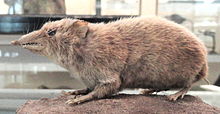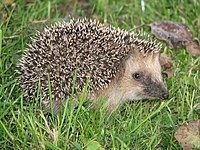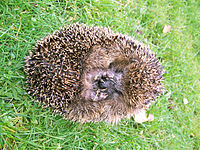Erinaceidae
![]()
This article is about the mammal family of hedgehogs, for other meanings see Hedgehog (disambiguation).
The hedgehogs (Erinaceidae) form a family of mammals whose best-known representatives are the species living in Europe, the brown-breasted hedgehog (Erinaceus europaeus) and the northern white-breasted hedgehog (Erinaceus roumanicus). The brown-breasted hedgehog is the species typically found in western and central Europe. Across eastern Central Europe (from western Poland through the Czech Republic and Austria to the Adriatic coast of northern Italy), there is an area about 200 kilometres wide where the range of the brown-breasted hedgehog overlaps with that of the white-breasted hedgehog.
In total, the family comprises 26 species distributed in Eurasia and Africa. They divide into two outwardly distinct subfamilies, the spiny hedgehogs (Erinaceinae) and the spineless rat or hair hedgehogs (Galericinae). The systematic position of hedgehogs is still controversial: traditionally they have been placed in the insectivores (Eulipotyphla), alternatively as a separate order (Erinaceomorpha) at the base of the higher mammals (Eutheria). Recent studies have made the former variant more likely again.
Etymology
Old High German igil (9th century), Middle High German igel, Old Saxon igil, Middle Low German ēgel, Middle Dutch ēghel, Dutch egel, Old English igil, Old Norse īgull, is related as an l-derivation to Greek échis (ἕχις) 'snake', from Indo-European *eĝhi- 'snake'.
To the same Greek, or Indo-European source form belong with n-suffix Greek echinos (έχΐνος), 'hedgehog, sea-urchin' and with Indo-European įo-suffix: Serbian Church Slavonic ježь, Russian ёж, Lithuanian ežys 'hedgehog'.
All these derivations are to be understood as 'snake-animal, snake-eater', since the hedgehog eats snakes as well as insects, frogs, mice, etc.
Features
General physique
Hedgehogs are small to medium-sized animals. Their head-torso lengths vary from 10 to 45 centimetres. The hedgehog species with the largest and heaviest specimens is the greater rat hedgehog, weighing up to 2 kilograms. In contrast, specimens of the lesser rat hedgehog weigh 20 to 80 grams. The tail length of hedgehogs is variable, some representatives of the rat hedgehogs have a long tail, while it is usually only a short stub in the spiny hedgehogs.
The limbs of hedgehogs are relatively short and unspecialized. The thumbs or big toes are not opposable, as in all insectivores, and the feet end in mostly five toes with sharp claws - only the African hedgehogs have four toes on the hind feet. The tibia and fibula are fused in the lower half, as in many insectivores.
Hedgehogs are sole walkers. In rat hedgehogs, the hind legs are slightly longer than the front legs to allow rapid escape.
Coat
The fur of hedgehogs is mostly inconspicuous shades of brown or grey. The spiny hedgehogs have spines on their backs and flanks as an effective defensive weapon (in the case of the brown-breasted hedgehog, there are about six to eight thousand). These spines are modified hollow hairs. Each spine is equipped with an erector muscle (Musculus arrector pili). Spiny hedgehogs can curl up into a ball when threatened. The curling of the body is a complex interaction of numerous muscles, including the caudo-dorsalis muscle, which runs from the caudal vertebrae to the back and erects the spines, and a ring muscle (Musculus sphincter cuculli), which holds the sphere closed to conceal unprotected body parts. The abdomen, face and limbs are covered with fur in spiny urchins.
In contrast, rat hedgehogs have no spines and therefore (and due to the usually longer tail) give a rather shrew-like impression. Their grey-brown to black fur can be silky-soft or rough, depending on the species. The defense strategy of these animals is flight.
Head and teeth
The skull of hedgehogs is elongated and flat. A distinctive feature is the closed zygomatic arch and the independent zygomatic bone, which distinguishes these animals from most other insectivores. The head sits on a short neck. The elongated, movable snout is equipped with tactile hairs. The eyes and ears are relatively large compared to other insectivores. The sense of smell and hearing are probably the most important senses in the search for food, while visual perception plays only a subordinate role.
The skull is relatively small, accordingly, the brain is also simply built and small compared to the body mass. However, the olfactory bulb is well developed. The hedgehog also uses the Jacobson's organ.
The teeth of hedgehogs are provided with pointed cusps and sharp enamel ridges and are very well adapted to their carnivorous diet. All species have comparatively many teeth, and in some representatives the original number 44 of teeth of the Higher Mammals is preserved. The foremost incisor is often larger than the other incisors, and the upper molars have four cusps, the hindmost molar often being reduced.
| Tooth formula | I | C | P | M | |
| 36–44 | = | 3 | 1 | 3–4 | 3 |
| 2–3 | 1 | 2–4 | 3 | ||
Digestive and reproductive tract
The digestive tract is very simply built. There is no appendix, the intestine is a simple tube and very short compared to the body length. In males, the testes are always located outside the abdominal cavity in scrotum-like folds of skin called cremasteric folds. The females have a two-horned uterus.

Spine in scanning electron microscope ("SEM"), 20 × magnification

Skull of a white-bellied urchin (Atelerix albiventris)

The short-tailed rat hedgehog belongs to the rat hedgehogs, the second group within hedgehogs.
Questions and Answers
Q: What is Erinaceidae?
A: Erinaceidae is a family of mammals in the order Eulipotyphla that includes hedgehogs of Eurasia and Africa and moonrats of South-east Asia.
Q: What are some animals included in Erinaceidae?
A: Erinaceidae includes hedgehogs of Eurasia and Africa and moonrats of South-east Asia.
Q: Did Erinaceidae belong to the order Insectivora in the past?
A: Yes, Erinaceidae belonged to the order Insectivora in the past.
Q: Is the order Insectivora in use currently?
A: No, the order Insectivora is not used anymore.
Q: What order is Erinaceidae included in now?
A: Erinaceidae is included in the order Eulipotyphla.
Q: Where are moonrats found?
A: Moonrats are found in South-east Asia.
Q: What is the most well-known animal in Erinaceidae?
A: The most well-known animal in Erinaceidae is the hedgehog.
Search within the encyclopedia

